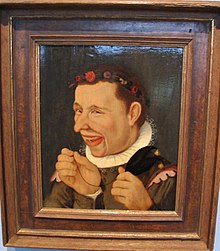Andreas Herneisen
Andreas Herneisen or Herneysen (* 1538 in Nuremberg ; † 1610 there ) was a German Renaissance painter .
Live and act
From 1562 Andreas Herneisen was named as a master in the Nuremberg council exits. In Nuremberg he painted numerous portraits of patricians such as the double portrait of Hans Sachs and himself. Andreas Herneisen stayed in Würzburg from 1578 to 1587 and - although a Protestant - received numerous commissions from the Würzburg prince-bishop Julius Echter . From 1590 to 1592 he painted the ceiling in the ballroom of the New Lusthaus on Schlossplatz in Stuttgart for Duke Ludwig von Württemberg . In 1593 Andreas Herneisen returned to his hometown and mainly made denomination pictures for Protestant parishes. In 1608/09 he worked again in Würzburg.
Works (selection)

- from 1562: portraits of Nuremberg patricians
- 1576: Double portrait of Hans Sachs and himself
- Painting of the Cistercian monastery church Aldersbach in Lower Bavaria
- Painting of the Protestant parish church in Beerbach in Middle Franconia
- 1581: Painting of Jacob's dream of the ladder to heaven today in the “Pilgrims & Pilgrims” museum in Dettelbach
- 1589: Donor picture in the Martinskapelle in Bürgstadt
- 1589/90: painting of the Martinskapelle in Bürgstadt
- 1590–1592: Ceiling painting of the ballroom of the New Lusthaus on Schlossplatz in Stuttgart with hunting scenes and landscapes
- 1601: Painting The Augsburg Confession for the Protestant Parish Church of St. Nicholas and Ulrich in Nuremberg- Mögeldorf
- 1602: Denomination picture in the Protestant parish church of Kasendorf in Upper Franconia
- 1606: Confessional painting in the Protestant parish church of Buchbrunn in Lower Franconia
- 1608/09: Work on the Würzburg Cathedral (ceiling paintings) and on the Marienberg Fortress
literature
- Wolfgang Meister: The Martinskapelle in Bürgstadt. Testimony to the artistic sense and zeal for faith of a rural community around 1600 . Edited by the Heimat- und Geschichtsverein Bürgstadt, Bürgstadt 2004, ISBN 3-00-015104-4 , pp. 68–87.
Web links
- Literature by and about Andreas Herneisen in the catalog of the German National Library
Individual evidence
- ^ Georg Dehio : Handbook of German art monuments - Bavaria I - Franconia . Deutscher Kunstverlag , Munich 1979, ISBN 3-422-00359-2 , p. 167 .
- ^ Georg Dehio : Handbook of German art monuments - Bavaria I - Franconia . Deutscher Kunstverlag , Munich 1979, ISBN 3-422-00359-2 , p. 640 .
- ^ The Kasendorfer denominational picture www.landschaftsmuseum.de (accessed on April 20, 2014)
- ↑ Stefan Kummer : Architecture and fine arts from the beginnings of the Renaissance to the end of the Baroque. In: Ulrich Wagner (Hrsg.): History of the city of Würzburg. 4 volumes; Volume 2: From the Peasants' War in 1525 to the transition to the Kingdom of Bavaria in 1814. Theiss, Stuttgart 2004, ISBN 3-8062-1477-8 , pp. 576–678 and 942–952, here: p. 606.
| personal data | |
|---|---|
| SURNAME | Herneisen, Andreas |
| ALTERNATIVE NAMES | Herneißen, Andreas; Herneyßen, Andreas |
| BRIEF DESCRIPTION | German painter |
| DATE OF BIRTH | 1538 |
| PLACE OF BIRTH | Nuremberg |
| DATE OF DEATH | 1610 |
| Place of death | Nuremberg |
